Bring user to ... end of funnel
Understanding what drives the user is one of the key tasks in developing an application interface or resource design. Fortunately, Bluma Vulfovna Zeigarnik put at our disposal a rather powerful lever, which has found extremely effective use in electronic commerce.
Bluma Vulfovna Zeygarnik is a gestalt psychologist and psychiatrist who has made a significant contribution to the creation of experimental psychology as a science. In 1927, she discovered that tasks that were not completed for one reason or another were given much more attention than those that had a logical conclusion. Today this phenomenon is called the Zeigarnik effect.
Below are some examples of how this effect is used in modern web design:
Method number 1: The degree of completion
One of the first methods that comes to mind when mentioning the “Zeigarnik effect” is a clear demonstration of how close the user is to the final goal. Quite often, this is implemented in the form of clearly specified and numbered stages of the process, intuitive progress bars, a list of tasks, etc. In addition, when it comes to the use of this technique in online trading, its effect is enhanced by the fact that explicit information about what steps the user has to go through during the order of products significantly reduces friction due to the ability to evaluate the necessary time costs.
An example of the application of this technique on VKontakte (image source http://seob.info/ )

Another use case:

Cons : This approach may conflict with the law of benefit and cost analysis. This is especially true for filling out a profile, since the necessary minimum of information allows you to fully use your account, and the time costs seem excessive to the user. This can be avoided if we accept a minimally filled profile not for 0 or 5%, but, say, for 60%. The prospect of filling 40% looks much less intimidating than 95. This does not mean that you should deceive the user, moreover, it is almost always fraught. It is about taking into account the time spent by the user on registration in the calculations.
Method number 2: Ecosystem of goods
Another common, and highly successful, approach that companies use is to create a harmonious ecosystem of products. This technique activates the “Zeigarnik effect” due to the fact that the consumer experiences a feeling of incompleteness of the “kit” if not all pieces of the mosaic are present in his “collection” of gadgets, programs or other products, and even more so if one or more elements are “inserted” from a completely different set (produced by another company).

Method number 3: Scoring
One of the most popular methods of increasing user participation on the Internet today, in addition to a sense of incompleteness, actively uses social proof. Scoring, visual presentation and public demonstration motivate the user to continue to use the resource or application, as he has a sense of control from the outside. The effect is enhanced by the publication of achievements and commentaries on them. The role of a constant reminder that you have something to strive for is played by the annoying TOP-10 (20, 50, 100).
Example from Microsoft Virtual Academy:

Another manifestation of this approach is the user's motivation to create content that will be evaluated by experts or other participants. Quite often, such materials are reviews, reviews or articles.
Movie Search:

Well and of course:

Method number 4: Gamification
The use of gaming mechanisms is becoming increasingly popular. Application designers often use the same principle that makes a gamer go through level after level of a toy, which, in general, is not so interesting, but the incompleteness of the process returns us to the fields of virtual battles again and again.

The main thing is that the awards marking one or another event motivate the user to achieve new "heights", emphasizing the fact that he has one (two, three, four, five) trophy to a new level.
Cons : Failure to implement can cause a project to fail.
In summary:
1. People care what other people think about them. This is sad, but extremely effective when it comes to motivating the user.
2. The correct use of this effect allows you to become addictive to your product, and the user will come back again and again.
3. Use a person’s natural desire for development and progress, rewarding him for certain actions.
Bluma Vulfovna Zeygarnik is a gestalt psychologist and psychiatrist who has made a significant contribution to the creation of experimental psychology as a science. In 1927, she discovered that tasks that were not completed for one reason or another were given much more attention than those that had a logical conclusion. Today this phenomenon is called the Zeigarnik effect.
Below are some examples of how this effect is used in modern web design:
Method number 1: The degree of completion
One of the first methods that comes to mind when mentioning the “Zeigarnik effect” is a clear demonstration of how close the user is to the final goal. Quite often, this is implemented in the form of clearly specified and numbered stages of the process, intuitive progress bars, a list of tasks, etc. In addition, when it comes to the use of this technique in online trading, its effect is enhanced by the fact that explicit information about what steps the user has to go through during the order of products significantly reduces friction due to the ability to evaluate the necessary time costs.
An example of the application of this technique on VKontakte (image source http://seob.info/ )

Another use case:
Cons : This approach may conflict with the law of benefit and cost analysis. This is especially true for filling out a profile, since the necessary minimum of information allows you to fully use your account, and the time costs seem excessive to the user. This can be avoided if we accept a minimally filled profile not for 0 or 5%, but, say, for 60%. The prospect of filling 40% looks much less intimidating than 95. This does not mean that you should deceive the user, moreover, it is almost always fraught. It is about taking into account the time spent by the user on registration in the calculations.
Method number 2: Ecosystem of goods
Another common, and highly successful, approach that companies use is to create a harmonious ecosystem of products. This technique activates the “Zeigarnik effect” due to the fact that the consumer experiences a feeling of incompleteness of the “kit” if not all pieces of the mosaic are present in his “collection” of gadgets, programs or other products, and even more so if one or more elements are “inserted” from a completely different set (produced by another company).

Method number 3: Scoring
One of the most popular methods of increasing user participation on the Internet today, in addition to a sense of incompleteness, actively uses social proof. Scoring, visual presentation and public demonstration motivate the user to continue to use the resource or application, as he has a sense of control from the outside. The effect is enhanced by the publication of achievements and commentaries on them. The role of a constant reminder that you have something to strive for is played by the annoying TOP-10 (20, 50, 100).
Example from Microsoft Virtual Academy:
Another manifestation of this approach is the user's motivation to create content that will be evaluated by experts or other participants. Quite often, such materials are reviews, reviews or articles.
Movie Search:
Well and of course:
Method number 4: Gamification
The use of gaming mechanisms is becoming increasingly popular. Application designers often use the same principle that makes a gamer go through level after level of a toy, which, in general, is not so interesting, but the incompleteness of the process returns us to the fields of virtual battles again and again.

The main thing is that the awards marking one or another event motivate the user to achieve new "heights", emphasizing the fact that he has one (two, three, four, five) trophy to a new level.
Cons : Failure to implement can cause a project to fail.
In summary:
1. People care what other people think about them. This is sad, but extremely effective when it comes to motivating the user.
2. The correct use of this effect allows you to become addictive to your product, and the user will come back again and again.
3. Use a person’s natural desire for development and progress, rewarding him for certain actions.
